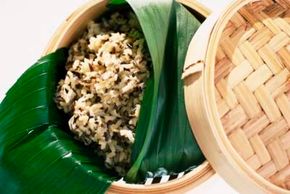Advertisement
- Q. I've heard that rice comes different grains. Can you tell me more about the types of rice?
- Q. Whenever I try to cook rice on the stovetop, it ends up either undercooked and burned on the bottom, or way too watery. Can you tell me how to make perfect steamed rice?
- For additional rice recipes and cooking tips, see
Q. I've heard that rice comes different grains. Can you tell me more about the types of rice?
A. Rice is one of the oldest cultivated grains in the world. It has long been, and still is today, the main staple in many Asian cultures. There are three commercial grades of rice: long, medium and short grain. The length of the rice kernel affects the texture of the cooked rice.
Long-grain rice is lower in starch than shorter-grained varieties, resulting in a less sticky finished product. It is a good choice for pilafs and rice salads. Medium-grain rice has a high starch content. When cooked, the kernels tend to be moist and sticky. It is perfect for croquettes and molded dishes.
Advertisement
Short-grain rice is the preferred type in Asia because it is easy to eat with chopsticks. It is also used for risotto, rice pudding and other sweet rice dishes.
Q. Whenever I try to cook rice on the stovetop, it ends up either undercooked and burned on the bottom, or way too watery. Can you tell me how to make perfect steamed rice?
A. Making great steamed rice does not require using a rice cooker. Preparing it on the stove can be easy, provided you use the correct rice-to-water ratio and method.
As a general rule of thumb, use 1 3/4 to 2 cups of water for each cup of rice, depending on if you are using short-, medium-, or long-grain rice. Use less water for shorter grains or firmer rice, more for longer grains or softer, stickier rice. Rinse rice grains before cooking to remove excess starch and any foreign particles.
Advertisement
In a medium saucepan with a tight-fitting lid, bring water and rice to a boil. Immediately reduce the heat to the lowest setting and simmer, covered, for 20 minutes. Do not lift the lid or stir the rice. When 20 minutes is up, just fluff the rice lightly with a fork and serve.
Here are a couple of easy trouble-shooting tips:
- If the rice is still hard or underdone in the center of the grain, add some extra water (no more than 1/4 cup) to create some steam. Continue cooking the rice over very low heat for another 5 minutes.
- If the rice is too wet, uncover the pot and cook over low heat to gently evaporate the excess water.
Q. How do you cook rice so that it turns out dry and the grains are separated? A. This pretty much depends on the type of rice you use. As we noted above, there are three commercial grades of rice -- long-, medium-, and short-grain -- and the length of the rice kernel affects the texture of the rice when it's cooked. Medium- and short-grain rice have a high starch content, which makes the cooked rice moist and sticky; long-grain rice has less starch, so it cooks up dry and fluffy. Each type of rice requires a different amount of liquid, so check the cooking directions on the package. For instance, brown rice -- which has been minimally processed -- and converted, or parboiled, rice take longer to cook than white rice and require more liquid (generally, 2 1/2 to 3 cups of liquid to 1 cup of rice). Another way to keep the grains separated is to add about a tablespoon of oil, butter, or margarine to the pot while cooking. This lubricates the individual grains and prevents them from adhering and clumping together. Another bit of advice: Don't stir rice while it's cooking, because stirring also will make it stickier. An easy way to make clump-free rice is to use the pilaf method: Heat 2 tablespoons butter in a medium saucepan. Add 1 cup long-grain rice. Cook and stir the rice over medium heat for 4 to 5 minutes or until rice turns opaque. Add 2 cups boiling chicken broth or water and 1/2 teaspoon salt. Cover and cook over low heat for 14 minutes or until rice is tender and water has been absorbed.
Advertisement
For additional rice recipes and cooking tips, see:
- How to Cook Rice
- Rice Recipes
- Steamed Rice Recipe
- Overview Of Grains
Advertisement
